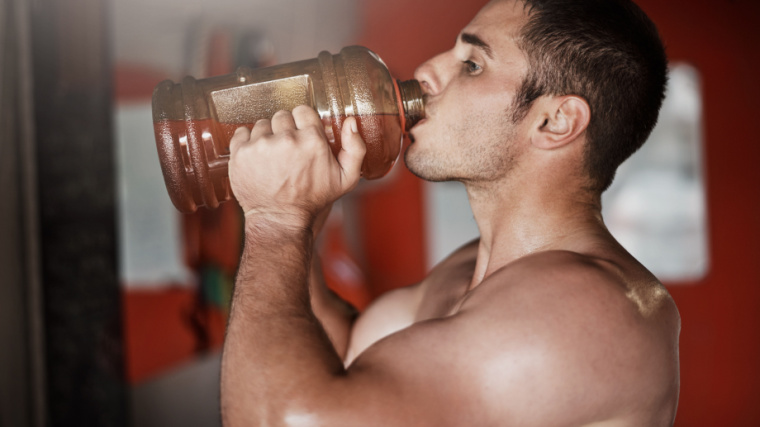Pre-workout supplements have become increasingly popular among fitness enthusiasts in recent years. It’s almost as if, are you even a serious lifter if you don’t dry scoop some pre-workout in the gym parking lot before your warm-up? Due to their prevalence within gym culture and notable performance-boosting effects, everybody has their go to pre-workout supplements whether it’s a…
The post What Does a Pre-Workout Do? appeared first on Breaking Muscle.
Pre-workout supplements have become increasingly popular among fitness enthusiasts in recent years. It’s almost as if, are you even a serious lifter if you don’t dry scoop some pre-workout in the gym parking lot before your warm-up?
Due to their prevalence within gym culture and notable performance-boosting effects, everybody has their go to pre-workout supplements whether it’s a simple cup of coffee (aka “caffeine”) or a scoop of the latest tropical punch-flavored, ultra-secret-ingredient formula.

The world of pre-workouts can be intimidating, sometimes rightfully so. You don’t want to spend more money than you have to. You don’t want to choose an ineffective formula. And you definitely don’t want to take something that makes you so jittery, you end up doing push-ups on the floor of the emergency room.
Here’s what to know about some of the most popular pre-workouts available, so you can approach your pre-training supplementation with a better idea of what should and shouldn’t be in there.
What Does a Pre-Workout Do?
- Potential Benefits
- Potential Drawbacks
- 10 Most Common Pre-Workout Ingredients
- How to Use a Pre-Workout
Potential Benefits of Using a Pre-Workout
Pre-workout supplements can be a game changer for many people. It’s a staple supplement category for many lifters, whether it’s something used before every workout or only when the planned session calls for it. It’s not necessary, but for lifters who want a high-performance edge, having a go to pre-workout is ideal.
Increased Motivation and Focus
A good pre-workout can help to get you in the right mindset on days when you’re paying more attention to the playlist in your headphones than the barbell in your hands. Even the most dedicated lifter has days when they’re just not feeling it, and a good pre-workout may be able to fill the gap.
Certain pre-workout ingredients have been shown to improve focus, concentration, even your mood. (1)(2) This can carry over to greater general energy levels, allowing you to attack the training session with higher intensity, as well as potentially better attention to technique.

You might also notice a better mind-muscle connection during certain exercises, which can help to recruit more muscle fibers and trigger greater muscle growth. (3)
Improved Strength, Power, and Endurance
Physiologically, a pre-workout can directly boost your performance in the gym by improving strength, increasing power output, or increasing endurance and delaying fatigue — all of which can translate to better training adaptations and improved results. (4)(5)(6)
Whether it’s a stimulant to create a stronger muscle fiber contraction or an ingredient to decrease your required rest periods, pre-workouts can have some significant and impactful influence on your training session. (7)
Cumulatively, these performance benefits can yield greater results from training. However, that doesn’t mean you should, or need to, rely on pre-workouts consistently to perform at a high level.
Even when used sporadically, these benefits can trigger responses that yield better results than you might otherwise find without strategic supplement usage.
Potential Drawbacks of Using a Pre-Workout
Here are the major concerns you should be on the look out for when purchasing a pre-workout supplement.
Proprietary Blends
The term “proprietary blend” describes a mixture of ingredients that is unique to a particular supplement brand. Unlike more transparent labeling practices which list the specific amounts of each ingredient, proprietary blends only list the total amount of the blend without specifying how much of a given ingredient is included in the formula.
This means that you’re not being told exactly how much of each ingredient you are getting. Imagine being served a hamburger: Would you rather be told it’s made of “meat mixture,” 20% ground beef and 80% ground hot dogs, or 100% ground beef? That’s basically the situation with proprietary blends.
With proprietary blends, you don’t know if you’re getting the ingredients you desire in a safe or effective dose. Supplement company take advantage of this gray area and often fill proprietary blends with cheap fillers and less effective ingredients, compared to relatively more expensive and more useful ingredients, to improve their profit margins while compromising on efficacy.
Many supplements also require some degree of troubleshooting, so it might take you one or two (or more) different pre-workout purchases to find a formula your body responds well to. If you are not responding well to a pre-workout, it can be hard to pinpoint an exact reason when you’re dealing with a vague proprietary blend. Learning which ingredients help and hurt you is crucial to finalizing your pre-workout choice.
Stimulant Overload
Stimulants, such as caffeine or yohimbine (and ephedrine before it was banned), are commonly found in pre-workout supplements. These substances work by increasing heart rate, blood pressure, and metabolic rate. While this can provide a temporary boost of energy, it can also put a strain on the cardiovascular system and increase the risk of potentially adverse health effects.

The very ingredients that make pre-workouts useful can also be abused by some individuals, especially if you’re prone to the side effects of stimulants. If you already have a high-level of caffeine intake, are anxiety prone, have high blood pressure, struggle with sleep, you should exercise care when it comes to stimulant-laden pre-workouts.
If you’re not careful with your pre-workout blend or the doses you use, you might not have the most pleasant experience. Palpations in the gym can land you on viral tik tok video or in the hospital. Nobody wants either of those. Always start with a half serving of any pre-workout and increase if appropriate.
10 Most Common Pre-Workout Ingredients
Whether you’re searching for a useful pre-workout formula or are looking to create your own by hand-picking specific compounds, here are some of the most reliable, science-based, effective pre-workout ingredients.
Caffeine
Caffeine is a well-known stimulant that is commonly found in coffee, tea, and other beverages. It is also added to many pre-workout supplements because of its ability to increase alertness and reduce fatigue. (8) Caffeine works by blocking the action of adenosine, a neurotransmitter that promotes sleepiness and relaxation. By blocking adenosine, caffeine makes you more alert. (9)
Without caffeine, many pre-workouts might not even feel like they are working. It’s the primary stimulant that leaves you feeling, “Whoa, I’m not as tired anymore. Time to hit the squat rack.”
Some pre-workout supplements may contain as little as 50 milligrams of caffeine per serving, while others may contain as much as 400 milligrams or more. For context, an “average” cup of coffee contains about 100 milligrams of caffeine.

Generally, you want to err on the lower end when using caffeine as a pre-workout, especially if you’re caffeine-sensitive or prefer a stimulant-free pre-workout (when training later in the day, for example, to avoid interrupting your sleep).
Don’t overlook the compounding effect caffeine can have over the course of a day. Because caffeine has a half-life of roughly five hours, if you have, for example, a large cold brew coffee with an extra shot at 9 a.m., you’re taking in roughly 325 milligrams of caffeine.
By 2 p.m., you’ve still got around 160 milligrams circulating in your system, so re-consider throwing back a pre-workout loaded with another 200+ milligrams of caffeine before your lunch break workout.
Synephrine
From the depths of Southeast Asia, synephrine is a compound derived from bitter orange. It’s been used to treat digestion and congestion issues, but can also be a stimulant in pre-workout.
Synephrine is a stimulant that is similar in structure and function to ephedrine — another stimulant that was commonly used in dietary supplements before being banned by the FDA in 2004. Like ephedrine, synephrine is thought to increase energy expenditure, reduce appetite, and enhance athletic performance. (10) However, synephrine is considered to be safer than ephedrine because it has a weaker effect on the central nervous system and is less likely to cause adverse side effects.
In pre-workout supplements, synephrine is often combined with caffeine and other ingredients that are intended to increase energy and focus during exercise. These supplements are marketed as a way to improve athletic performance, increase muscle strength, and reduce fatigue. (11)
Research has shown high doses up to 100 to 200 milligrams per day are tolerable depending on body weight, but more common effective doses are closer to 50 milligrams per day.
While synephrine may provide some benefits for exercise performance, it is important to be aware of the potential risks and side effects associated with its use. Some studies have suggested that synephrine can increase blood pressure and heart rate, which can be dangerous for people with certain medical conditions, such as hypertension or heart disease.
Yohimbine
Yohimbine is a potent stimulant that works by blocking alpha-2 adrenergic receptors in the body. This action can increase blood flow which is why many tout it as being helpful with treating erectile dysfunction.
But nonetheless, some people swear by the muscle pumps from yohimbine. Mechanistically, yohimbine has also been shown to increase the release of norepinephrine, a hormone that can stimulate fat metabolism and promote weight loss. Although, actual fat loss recorded in studies seems minimal. (12)

Doses from 10 to 20 milligrams are generally effective, but, similar to other stimulants, yohimbine can pose blood pressure and cardiovascular risks when combined with other stimulants.
Beta-Alanine
Beta-alanine is a non-essential amino acid that is naturally produced by the body. Beta-alanine has gained popularity among athletes and bodybuilders, due to its potential to enhance athletic performance and increase muscle endurance. (13)
Beta-alanine works by increasing the concentration of carnosine in the muscles. Carnosine is a dipeptide found in high concentrations in fast-twitch muscle fibers — the fibers responsible for explosive power and strength. Carnosine acts as a buffer, helping to prevent the build-up of lactic acid in the muscles during exercise.
In layman’s terms, it allows you to push longer and endure higher intensities because it delays muscle-burning. (14) This can lead to improvements in athletic performance, especially in activities that require extended bouts like endurance work or high-rep sets with minimal rest periods. It’s also known for producing a “tingly” feeling which can be hit or miss for people. Two to five grams per day have been shown to be effective.
Highly Branched Cyclic Dextrin
Highly branched cyclic dextrin is essentially pure carbohydrates for performance. Unlike many other types of carbohydrates, cyclic dextrin is “highly branched” which simply means it is rapidly absorbed by the body.
It provides your body fast-acting carbs to replenish muscle and liver glycogen while maintaining blood glucose levels. The ergogenic effects of carbohydrates are well-established, especially for high intensity interval training or endurance training. (15)

For some of your more intense workouts, this is a useful ingredient, especially when you don’t want to stomach carbohydrate-dense foods like potatoes or rice near your training session. As a carb source, as little as 15 grams per workout have been shown to be beneficial.
Citrulline
Citrulline is a non-essential amino acid found in watermelon and certain other fruits. If you’ve ever overheard locker room advice about drinking watermelon or pomegranate juice before a workout, there is actually some truth to that.
Citrulline is known to stimulate nitric oxide, which improves blood flow, increases aerobic performance, and gives you those tremendous pumps everybody talks about. (16)
Citrulline has ergogenic properties making it a seemingly perfect pre-workout ingredient. To increase nitric oxide production, six grams is the minimum recommended dose. Depending on your body weight and individual metabolism, you might need doses as high as eight or 12 grams to get noticeably bigger pumps.
BCAAS or Amino Acids
Many pre-workout supplements will have amino acids or branched chain amino acids. While these amino acids can be useful, most people already get plenty in a protein-sufficient diet.
Having incomplete amino acids will always be inferior to a complete protein like whey. These standalone amino acid formulas in pre-workouts often significantly spike the price of your pre-workout while providing little benefit.
If you want extra calories in your pre-workout, you’re better off opting for carbs like highly branched cyclic dextrin instead, which will bring along improved performance.
L-Tyrosine
L-tyrosine is a non-essential amino acid that is found in many protein-rich foods, including meat, fish, and dairy products. It has gained popularity as an ingredient in pre-workout supplements due to its potential to enhance mental and physical performance. (17)
L-tyrosine works by increasing the production of neurotransmitters in the brain, such as dopamine and norepinephrine. These neurotransmitters are important for mood, motivation, and focus, and they play a key role in regulating the body’s stress response. By increasing the production of these neurotransmitters, L-tyrosine can help to improve mental focus during exercise.

However, L-tyrosine seems to primarily have a noticeable effect in stressful, anxious, or sleep-deprived scenarios. It could be considered the “sleep-deprived saver” — it might not make a big difference in your usual routine on days when you have sufficient sleep, but if your night’s sleep pattern is disrupted, it may be more beneficial. The effective dose seems to be between 500 to 2,000 milligrams depending on your body weight.
L-Theanine
L-theanine is an amino acid commonly found in certain tea leaves. L-theanine works by increasing the production of neurotransmitters in the brain, particularly gamma-aminobutyric acid (GABA). (18) GABA is a calming neurotransmitter that helps to reduce feelings of anxiety and stress.
It has many cognitive benefits as well. It doesn’t sedate or make you tired, but it could be seen as more of a “downer,” compared to over-the-top stimulants working as “uppers” as they ramp up your nervous system. Theanine generally provides a more mellow energy and is often added to pre-workouts to serve as a way to add more performance clarity while reducing the jittery side effects of stimulants like caffeine.
L-theanine also has a relatively positive safety profile at any dose, but around 300 milligrams is recommended as a minimum effective dosage.
Creatine Monohydrate
Creatine is an extremely popular ingredient, considered one of the most thoroughly researched sports supplements in the field, known for its ability to enhance physical performance and muscle growth. (19)(20) It is a naturally occurring compound that is found in several animal products such as red meat and fish.
Creatine works by increasing the body’s levels of phosphocreatine, which is used to produce energy during high-intensity exercise. By increasing the body’s stores of phosphocreatine, creatine can help to improve athletic performance, increase strength, and reduce fatigue. It’s even been shown to boost cognitive function and general brain health. (21)
It also draws water into your muscles cells, signaling for anabolic processes. It’s almost like the strength and hypertrophy version of beta-alanine. Despite its common everyday use and scientific reliability, creatine only works once your muscles are fully saturated. This process takes a couple weeks of consistent use.
If you don’t take your pre-workout daily, you will have a hard time leveraging creatine’s benefits. Many brands also add creatine to spike up the price of their pre-workout, due to the “name recognition” of the ingredient, even though creatine on its own is relatively inexpensive.
While it might be more convenient to have it in your pre-workout, a better approach is to supplement with creatine separately, using a standalone creatine monohydrate powder. This is a way to save money while maximizing creatine stores within the muscles, since you can take creatine daily without any additional pre-workout ingredients.
How to Use Pre-Workouts
One of the most overlooked aspects to pre-workouts is taste. Make sure it tastes good, so you’ll actually want to take it, and make sure you feel energized without your blood pressure exploding or your sleep-quality tanking.

Be on the lookout for a pre-workout that has the ingredients you want in the doses you need, and be careful about the number of stimulants in them. Whenever possible, avoid proprietary blends.
For most ingredients to work well and be properly digested and absorbed, take your pre-workout 30 to 60 minutes before your workout. Most people just take it before they leave for the gym, regardless of timeframe. Worse, they might quickly down a pre-workout in the gym’s parking lot while they’re loading up their favorite playlist.
The only other thing you have to consider is how often you take a pre-workout. For some lifters, taking a pre-workout boost before every workout has become a part of gym life — just another ritual like packing your gym bag or filling your water bottle.
Others prefer to take a pre-workout only on days they’re dragging and need a good pump or an extra boost to hit a new PR. This latter approach should help to make sure you don’t desensitize yourself to any of the ingredients, especially stimulants like caffeine, which can quickly lose it’s effects if taken too often in high doses. (22)
Pre-workouts can also be useful if you train fasted, and they may be less needed if you train well-fed. The carbohydrate, sodium, and nutrient component of your pre-workout meal can improve your performance, mental alertness, and muscle pumps even without the stimulating jitters.
Like anything else in fitness, you have to experiment with what works best for you when it comes to taking a pre-workout. As you find with most things in the gym, a bit of patience, combined with well-informed periods of trial and error, should gradually steer you in the right direction of safe and effective goal-focused results.
References
- Jung, Y. P., Earnest, C. P., Koozehchian, M., Galvan, E., Dalton, R., Walker, D., Rasmussen, C., Murano, P. S., Greenwood, M., & Kreider, R. B. (2017). Effects of acute ingestion of a pre-workout dietary supplement with and without p-synephrine on resting energy expenditure, cognitive function and exercise performance. Journal of the International Society of Sports Nutrition, 14, 3. https://doi.org/10.1186/s12970-016-0159-2
- Curtis, J., Evans, C., Mekhail, V., Czartoryski, P., Santana, J. C., & Antonio, J. (2022). The Effects of a Pre-workout Supplement on Measures of Alertness, Mood, and Lower-Extremity Power. Cureus, 14(5), e24877. https://doi.org/10.7759/cureus.24877
- Calatayud, J., Vinstrup, J., Jakobsen, M. D., Sundstrup, E., Brandt, M., Jay, K., Colado, J. C., & Andersen, L. L. (2016). Importance of mind-muscle connection during progressive resistance training. European journal of applied physiology, 116(3), 527–533. https://doi.org/10.1007/s00421-015-3305-7
- Martinez, N., Campbell, B., Franek, M., Buchanan, L., & Colquhoun, R. (2016). The effect of acute pre-workout supplementation on power and strength performance. Journal of the International Society of Sports Nutrition, 13, 29. https://doi.org/10.1186/s12970-016-0138-7
- Schwarz, N. A., , PhD, & McKinley-Barnard, S. K., , PhD (2020). Acute Oral Ingestion of a Multi-ingredient Preworkout Supplement Increases Exercise Performance and Alters Postexercise Hormone Responses: A Randomized Crossover, Double-Blinded, Placebo-Controlled Trial. Journal of dietary supplements, 17(2), 211–226. https://doi.org/10.1080/19390211.2018.1498963
- Beck, T. W., Housh, T. J., Schmidt, R. J., Johnson, G. O., Housh, D. J., Coburn, J. W., & Malek, M. H. (2006). The acute effects of a caffeine-containing supplement on strength, muscular endurance, and anaerobic capabilities. Journal of strength and conditioning research, 20(3), 506–510. https://doi.org/10.1519/18285.1
- Martinez, N., Campbell, B., Franek, M. et al. The effect of acute pre-workout supplementation on power and strength performance. J Int Soc Sports Nutr 13, 29 (2016). https://doi.org/10.1186/s12970-016-0138-7
- Ruxton, C.H.S. (2008), The impact of caffeine on mood, cognitive function, performance and hydration: a review of benefits and risks. Nutrition Bulletin, 33: 15-25. https://doi.org/10.1111/j.1467-3010.2007.00665.x
- Delleli, S., Ouergui, I., Messaoudi, H., Trabelsi, K., Ammar, A., Glenn, J. M., & Chtourou, H. (2022). Acute Effects of Caffeine Supplementation on Physical Performance, Physiological Responses, Perceived Exertion, and Technical-Tactical Skills in Combat Sports: A Systematic Review and Meta-Analysis. Nutrients, 14(14), 2996. https://doi.org/10.3390/nu14142996
- Stohs, S. J., Preuss, H. G., & Shara, M. (2012). A review of the human clinical studies involving Citrus aurantium (bitter orange) extract and its primary protoalkaloid p-synephrine. International journal of medical sciences, 9(7), 527–538. https://doi.org/10.7150/ijms.4446
- Ruiz-Moreno, C., Del Coso, J., Giráldez-Costas, V., González-García, J., & Gutiérrez-Hellín, J. (2021). Effects of p-Synephrine during Exercise: A Brief Narrative Review. Nutrients, 13(1), 233. https://doi.org/10.3390/nu13010233
- Ostojic S. M. (2006). Yohimbine: the effects on body composition and exercise performance in soccer players. Research in sports medicine (Print), 14(4), 289–299. https://doi.org/10.1080/15438620600987106
- Trexler, E. T., Smith-Ryan, A. E., Stout, J. R., Hoffman, J. R., Wilborn, C. D., Sale, C., . . . Antonio, J. (2015). International society of sports nutrition position stand: Beta-Alanine. Journal of the International Society of Sports Nutrition, 12(1), 30. doi: 10.1186/s12970-015-0090-y
- Derave, W., Everaert, I., Beeckman, S., & Baguet, A. (2010). Muscle carnosine metabolism and beta-alanine supplementation in relation to exercise and training. Sports medicine (Auckland, N.Z.), 40(3), 247–263. https://doi.org/10.2165/11530310-000000000-00000
- Furuyashiki, T., Tanimoto, H., Yokoyama, Y., Kitaura, Y., Kuriki, T., & Shimomura, Y. (2014). Effects of ingesting highly branched cyclic dextrin during endurance exercise on rating of perceived exertion and blood components associated with energy metabolism. Bioscience, biotechnology, and biochemistry, 78(12), 2117–2119. https://doi.org/10.1080/09168451.2014.943654
- Pérez-Guisado, J., & Jakeman, P. M. (2016). Citrulline malate enhances athletic anaerobic performance and relieves muscle soreness. Journal of Strength and Conditioning Research, 30(10), 2937-2942. doi: 10.1519/jsc.0000000000001591
- Stecker, R. A., Harty, P. S., Cottet, M. L., & Jagim, A. R. (2019). The effects of tyrosine supplementation on clinical and healthy populations under stress or cognitive demands – a review. Journal of the International Society of Sports Nutrition, 16(1), 1-14. doi: 10.1186/s12970-019-0318-5.
- Nobre, A. C., Rao, A., & Owen, G. N. (2008). L-theanine, a natural constituent in tea, and its effect on mental state. Asia Pacific journal of clinical nutrition, 17 Suppl 1, 167–168.
- Wu, Shih-Hao, et al. “Creatine Supplementation for Muscle Growth: A Scoping Review of Randomized Clinical Trials from 2012 to 2021.” Nutrients, U.S. National Library of Medicine, 16 Mar. 2022, https://www.ncbi.nlm.nih.gov/pmc/articles/PMC8949037/
- Chilibeck, P. D., Kaviani, M., Candow, D. G., & Zello, G. A. (2017). Effect of creatine supplementation during resistance training on lean tissue mass and muscular strength in older adults: a meta-analysis. Open access journal of sports medicine, 8, 213–226. https://doi.org/10.2147/OAJSM.S123529
- Rawson, E. S., & Venezia, A. C. (2011). Use of creatine in the elderly and evidence for effects on cognitive function in young and old. Amino acids, 40(5), 1349–1362. https://doi.org/10.1007/s00726-011-0855-9
- Quiquempoix, M., Drogou, C., Erblang, M., Van Beers, P., Guillard, M., Tardo-Dino, P. E., Rabat, A., Léger, D., Chennaoui, M., Gomez-Merino, D., Sauvet, F., & Percaf Investigator Group (2023). Relationship between Habitual Caffeine Consumption, Attentional Performance, and Individual Alpha Frequency during Total Sleep Deprivation. International journal of environmental research and public health, 20(6), 4971. https://doi.org/10.3390/ijerph20064971
Featured Image: MARKOFIT PRODUCTION / Shutterstock
The post What Does a Pre-Workout Do? appeared first on Breaking Muscle.






